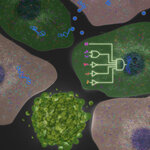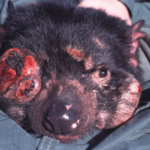Cancer Research

A new study, published in Science, describes a multi-gene synthetic circuit that can distinguish between cancer and non-cancer cells, after which it can target the cancer cells for destruction. Through recognizing five intracellular cancer-specific molecules, the circuit is able to accurately identify cancer cells, which, after detection, are destroyed.
Finding the right combination of molecules was challenging. Looking among microRNA molecules, which are post-transcriptional regulators, the researchers were eventually able to find one miRNA combination that was typical for HeLa, or cervical…

As health care costs continue to rise and more people want more services for less money, it will be important that doctors engage in evidence-based medicine.
The Centers for Disease Control and Prevention (CDC) have determined that the majority of primary care providers continue to recommend annual cervical cancer screening, though cervical cancer screening guidelines recommend a combination of a Papanicolaou test and an HPV test, known as an HPV co-test, for women 30 years of age and older.
Upon screening, if the results of these two tests are normal, women can wait 3 years for…
Usually when you think of drugs, you think of mules, but camels have also unique properties, except those can be used in future drug development.
Members of the camelid family have particular heavy-chain antibodies in their blood known as nanobodies that may serve as therapeutic proteins. One of the most powerful advantages of nanobodies is that they can be easily attached to other proteins and nanoparticles by simple chemical procedures.
Scientists at the Department of Pharmaceutics and Analytical Chemistry, University of Copenhagen, have designed nanoparticle systems of smaller than…

A new cancer therapy has been recently described in the New England Journal of Medicine, and Science Translational Medicine. The therapy is based on the idea that T cells, the frontline fighters of the human immune system are quite good at their job, which is recognizing intruding cells and starting a cascade of events that will eventually lead to their demise. So, engineering these cells to recognize cancer cells could be a good start in the fight against cancer.
This, however proved to be quite difficult.
Now, a research group at Pennsylvania University has designed a new gene that can be…

Cancer is one of the scourges of modern society. An increasing number of people are fighting it, and a lot of research is being done in order to understand it better, hopefully leading to treatments or cures.
At present, the dominant theory is that cancer arises from a handful gene mutations. But recently, Peter Duesberg and his colleagues at UC Berkeley have launched the idea that cancer instead arises from chromosome disruptions, and that this, in fact, constitutes a form of speciation. So, according to this view, cancers are newly evolved species, as they have new chromosomal karyotypes.…

I confess.
I had cancer.
And stem cells might be to blame!
At the relatively young age of 42, I was diagnosed with what is supposed to be an older man’s disease: prostate cancer.
How could this happen to me? It could be the fault of stem cells.
No, I don’t mean some rogue stem cells created in my own lab that attacked me, but rather I’m talking about my own perhaps slightly imperfect stem cells that might have gone rogue.
You see scientists are realizing that for many, but not all cancers, a unique type of stem cell called a “cancer stem cell” might be to blame.
As we live,…

I confess.
I had cancer.
And stem cells might be to blame!
At the relatively young age of 42, I was diagnosed with what is supposed to be an older man’s disease: prostate cancer.
How could this happen to me? It could be the fault of stem cells.
No, I don’t mean some rogue stem cells created in my own lab that attacked me, but rather I’m talking about my own perhaps slightly imperfect stem cells that might have gone rogue.
You see scientists are realizing that for many, but not all cancers, a unique type of stem cell called a “cancer stem cell” might be to blame.
As we live,our…

I confess.
I had cancer.
And stem cells might be to blame!
At the relatively young age of 42, I was diagnosed with what is supposed to be anolder man’s disease: prostate cancer.
How could this happen to me? It could be the fault of stem cells.
No, I don’t mean some rogue stem cells created in my own lab that attacked me, but rather I’m talking about my own perhaps slightly imperfect stem cells that might have gone rogue.
You see scientists are realizing that for many, but not all cancers, a unique type of stem cell called a “cancer stem cell” might be to blame.
As we live,our…

I confess.
I hadcancer.
And stemcells might be to blame!
At therelatively young age of 42, I was diagnosed with what is supposed to be anolder man’s disease: prostate cancer.
How couldthis happen to me? It is probably thefault of stem cells, I figure.
No, I don’tmean some rogue stem cells created in my own lab that attacked me, but rather I’mtalking about my own perhaps slightly imperfect stem cells that might have gonerogue.
You seescientists are realizing that for many, but not all cancers, a unique type ofstem cell called a “cancer stem cell” might be to blame.
As we live,…

A new finding may mean that nearly all leukemia and lymphoma patients in need of a transplant can find donors.
Results of two clinical trials show transplant results with half-matched bone marrow or umbilical cord blood are comparable to fully matched tissue, thanks in large part to the availability of effective anti-rejection drugs and special post-transplant chemotherapy.
Plans are under way for a four-year randomized trial for so-called haploidentical marrow or cord blood transplants in 380 patients to begin late this year or early next year. Many large medical centers, including…